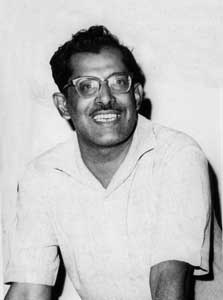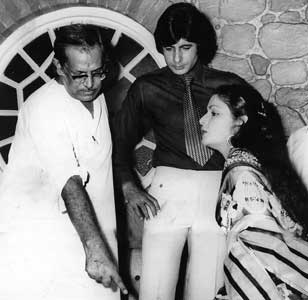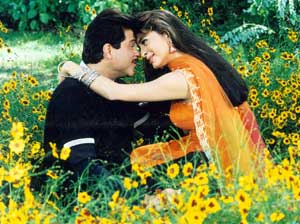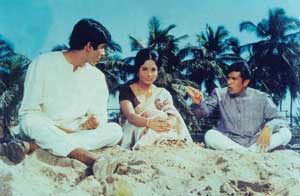Arts
Jeena Isi Ka Naam Hai

|
Hrishikesh Mukherjee dead at 84. Anand may not have approved in full measure. After all, that adorable character from the 1970 eponymous film had declared with die-hard flamboyance *Zindagi badi honi chahiye, lambi nahi.* (Literally translated: Have a “big” life, not a long one.) The line was dialogue-writer Gulzar’s; the sentiment unmistakably director Mukherjee’s. But his mourners, a now-middle-aging generation of Indian filmgoers who first came under the spell of mainstream Hindi cinema in the 1950s and 1960s, were agreed nonetheless that this Babu Moshai had lived a life that was truly “big” in creative dimension.
Hrishida had not just outlived Anand’s dictum. He also seemed to have clumsily outgrown Bollywood itself and was clearly out of his depth working in what might have seemed to the veteran director like an alien industry with alien aesthetic and production values. Braving failing health, he last directed *Jhoot Bole Kauwa Kaate* in 1998, a swan-song that was sadly off-key. A warmed-up rehash of an earlier film (*Golmaal*), it disappointed on every count – thematic content, narrative flair, music and finally, box-office returns. The film’s failure began a period of intense personal loneliness and desolation in Mukherjee’s life which culminated in his death. The cliché that a thespian’s death marks the end of an era for once rang true. No other Hindi film-maker’s work typified the way the Indian middle-class lived and loved in the days before the “multinational” economic-reforms invasion of the 1990s topsy-turvied its near-frugal lifestyle and Nehruvian values. True, this *gharana* of film-making had other talented adherents – notably Basu Chatterjee, Gulzar, Sai Paranjpe and the late Basu Bhattacharya – but Hrishida was their undisputed torch-bearer and senior, both in age as well as all-round film-making ability and influence. It’s a point of telling significance that none of these worthies has directed any memorable film for more than a decade. To write a Hrishida obituary therefore is to pay moist-eyed tribute to an entire genre of Indian film-making that is now extinct. Mukherjee began as a film editor and assistant director to Bimal Roy, another great film-maker from his native Bengal. The experience he gained from both these tasks shaped his outlook and left an indelible stamp on all his films. He loved editing movies, and openly admitted it was his first love. Perhaps it stemmed from his own latent and unspoken urge to bring a sense of order to an imperfect and disorderly world. Hrishida’s services were always available gratis – time permitting – to any young “new wave” film-maker. He had a soft corner for such directors, much to the chagrin of the rest of commercial Bollywood which hated Mukherjee for supporting the likes of Mani Kaul and Kumar Shahani during his tenure as de facto chief of National Film Development Corporation, a state-owned film financing and subsidizing firm. “I’m very fond of these boys,” he told me when Indian new-wave cinema peaked in the 1970s. “And I have nothing but admiration for their courage to push the frontiers of film art – something I’ve never dared to do.”
But what he as a director managed, without any fuss or self-conscious derring-do, was to deploy his solid technical knowledge of film-editing grammar to regulate his shot-taking style, thus curtailing the number and the length of his takes. Result: an enviable economy in terms of raw-stock consumption as well as studio time. An anecdote reflects the importance he gave to film editing. Mukherjee ran into a magazine reporter after he had completed the shooting schedule of *Asli Naqli,* a 1962 romance starring Dev Anand and Sadhana. The reporter asked how the project was progressing. Tongue firmly in cheek, Mukherjee quipped: “The *naqli* part of the project is over, and I’m looking forward to the *asli* part – the editing.” Stars, I suspect, were a species Hrishida viewed and accepted as a necessary evil in his scheme of things. It was a taste for big marquee-names he had obviously inherited from Bimal Roy. In fact, Mukherjee outdid his mentor in this regard by working with each of the star-trinity (Dilip-Raj-Dev) within the first five years of his directorial career. Like Roy, he was astute however in ensuring that the star’s on-screen mannerisms never got in the way of the character, and that the star’s remuneration never inflated the film’s budget beyond viable limits. The star, in turn, was often willing to forego the usual fat fee in return for featuring in a project of substance, in a landmark film guaranteed to enhance the star’s status as an actor. No one complained about this win-win situation, least of all the distributors and exhibitors who raked in ample profits from Mukherjee’s films. In addition, he possessed an eye for picking a potential winner (Jaya Bhaduri and Amitabh Bachchan, among others) and an uncanny knack for balancing newcomers with established stars. And so there was Dilip Kumar romancing a fresh Bengali import Suchitra Sen in *Musafir,* Rajesh Khanna facing a callow Amitabh Bachchan in *Anand,* Balraj Sahni playing husband to an inexperienced Leela Naidu in *Anuradha,* and Dharmendra with a host of guest-stars opposite first-timer Jaya Bhaduri in *Guddi.*
Perhaps his only shortcoming in dealing with stars was his widely-reported reluctance to crack the whip on undisciplined actors – something unheard of in a Bimal Roy project. Hrishida indulged his actors like a favourite uncle, and so few were surprised when he called for his constant companion (his chess-board) on the sets after Rekha and Rajesh Khanna failed repeatedly to turn up for shooting *Khubsoorat* and *Bawarchi* respectively, and Amitabh Bachchan and Rajesh Khanna got into a childish tiff over who would die in the last scene of *Namak Haraam.* Whereas the script called for Khanna’s “death,” both wanted to be the film’s sole martyr. Only when the argument raged on and became a time-consuming stalemate, did Hrishida resolve it by threatening to have both the characters killed! Amitabh finally relented. Like Bimal Roy who was known to be a more-than-decent violinist, Hrishikesh Mukherjee was a connoisseur too, having been born into a musical famil. His brother Kashinath Mukherjee was a well-known sitar player in Calcutta. And like Roy, he depended heavily on songs to punctuate his film stories. Think of *Anari, Anuradha, Chhaya, Asli Naqli, Aashiq, Saanjh Aur Savera, Anupama* and *Anand* – and what strikes you is the thread of melodious numbers running through all of them. His innate musical sense prompted the inclusion of a hard-core Hindustani classical number in his debut film *Musafir,* a duet sung by Lata Mangeshkar and – hold your breath – Dilip Kumar! Playback singers, including queen-bee Lata, were often amazed at Mukherjee’s ability to suggest an apt musical nuance and explain its rendition in notational parlance at his song recordings.
Despite accommodating all the major trappings of Hindi commercial cinema – established stars, song-and-dance routines, traditional story-telling patterns – Mukherjee’s films never strayed far from a compassionate portrayal of basic middle-class identities and their resultant bread-and-butter aspirations. Take his lead characters. You’ll find the hero working as a full-time professional for his living: Dilip Kumar as a music teacher in *Musafir,* Balraj Sahni as a doctor in *Anuradha,* Dharmendra as an engineer in *Satyakam,* Amitabh Bachchan as an industrialist and Rajesh Khanna as a trade-unionist in *Namak Haraam,* and even the perennial bumbler Amol Palekar as a qualified chartered accountant in *Golmaal.* By assigning his heroes a regular 10-to-5 job, the film-maker rooted them firmly in their social milieu and made their concerns all the more palpable for his audience. It was – at the very least – a sensitive nod to the fact that we all spend a major bulk of our waking hours pursuing a vocation and also to the overwhelming probability that our vocation could be instrumental in shaping our world-view. If all this sounds just too mundane, obvious and mandatory for any believable story, start counting the number of “successful” films in the last decade that have met this criterion. Do you recall what Shahrukh Khan as the hero of *Kuch Kuch Hota Hai* – an all-time Bollywood blockbuster – does for a living? And how many screen minutes does he spend actually working on a job? It was this abiding respect Mukherjee had for honest and hard-working professionals coupled with his disarming humility that came through loud and clear in a lengthy meeting I had with the film-maker several years ago. After an interview about film-related matters in the confines of his study – during which he voted for *Satyakam* as his best work, and named Satyajit Ray as the most accomplished Indian film-maker – we settled on the porch of his seaside bungalow in the Bombay suburb of Bandra with mugs of tea and a mellowing sun for auburn-hued company. He talked about his long-time friend Raj Kapoor. The man’s commitment to cinema was matched, he said, only by his loyalty to friends, justifying the dedication of *Anand* to Kapoor with whom Hrishida had first conceived the project. He then talked of his scientist son. “You should be interviewing him, not me,” Hrishida said sharply. “He works very hard exploring the secrets of science so it can benefit mankind, and what do I do? Make people sing and dance, and create empty illusions to entertain others. It’s really nothing compared to what professionals like my son do for years on end without expecting material rewards.” He was moved to tears. (I wonder if he said something similar to President K.R.Narayanan while accepting the Padma Vibhushan in 2001.) But that evening, Hrishida’s tears reminded me of Balraj Sahni in *Anuradha.* The doctor-hero, forever busy caring for patients in a ramshackle village, suddenly realizes he has been grossly neglecting his young and pretty singer-wife. The realization has a profound effect and he breaks down into uncontrollable sobs. What about Hrishida’s own wife? Mukherjee’s personal life remained a mystery even to his close associates. And given his high-priest stature in the industry, no newspaper or magazine – not even the shamelessly gossipy rags – ever dared to probe it. My senior journalist colleagues had warned me to steer clear of any discussion about his wife who, according to the grapevine, was lived alone in Calcutta for several years. When she was mentioned in passing that day, Hrishida was cryptic and deftly steered the conversation to another less controversial topic. To be sure, my curiosity about Hrishida’s personal relationships goes way beyond the realm of gossip. Surely, celebrities have the right to privacy and the dignity of being spared the media scrutiny of their private doings. But from where does a reclusive artiste, particularly one who comments on the human condition through an exploration of inter-personal relationships, tap into the subtle details that impart a throbbing credibility and a gentle humor to the intimacy shared by life-mates? Is a combination of mere imagination and second-hand sources like fictional stories good enough? At least in Hrishida’s case, we’ll probably never know.
What we do know and now cherish are his memorable characters. Three of them spring straight to mind. Ashok Kumar in *Aashirwaad* and Rajesh Khanna in *Anand* are “heroes” in unheroic – i.e. non-romantic – parts that defy the conventional mold of a Bollywood lead characters. My ultimate favourite however is Mrs.D’Sa, the landlady of *Anari* (1959) whose sharp and relentless tongue drips undiluted acid, but whose heart is pure gold. Mukherjee, I suspect, was inspired by a similar character in Bimal Roy’s 1953 masterpiece *Do Bigha Zameen.* But the *DBZ* character was a minor cog in the story and at best evoked amused and sympathetic smiles. Mrs.D’Sa, in comparison, is a veritable Bollywood institution. You kept seeing shades of her acerbic personality in motherly characters down the years in lesser films by lesser film-makers, and Mukherjee himself reprised the character (with the same actress Lalita Pawar) as the head-nurse in *Anand.* And while the *Anand* “life-line” with which this piece began is a heart-warming bit of dialogue that’s become as legendary as the *Godfather* offer one can’t refuse, spare a thought for a scene from the brilliantly scripted *Anari.* An honest but unemployed Raj Kapoor traces industry magnate Motilal to a glitzy restaurant to return his misplaced wallet stuffed with currency notes. Motilal gestures toward the revelers at a party in progress on the dance floor, and says: “Yeh woh log hain jinhe raste par batwe milay, magar unhon ne wapas nahi kiye.” (These are folks who found lost wallets on roads, but never returned them.) I have yet to find a more damning comment on the country’s middle-class, which is so willing to compromise its values in pursuit of material pleasures. Was Hrishida’s 1959 film crystal-gazing into an India of the 21st century? |





You must be logged in to post a comment Login